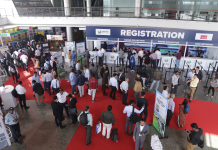We caught up with Ajay RaoRane, assistant vice president of Sales for Digital Printing at Domino Printech India at the company’s stand at Labelexpo in Brussels. RaoRane said that the company is “Very positive and upbeat about the Indian market. This positivity is a result of our engagement with Indian customers and their direct feedback and encouragement.”
Domino Printech India’s commitment to bring its inkjet technology to the label and other print production markets in the country has led it to use Multitec’s flexo printing units and unwind and rewind to build hybrid digital label presses for its Indian customers. Multitec is the leading Indian manufacturer and exporter of narrow web flexo presses. Based in Faridabad, Multitec is also at Labelexpo with live demonstrations of its narrow web flexo label press that has been sold to a Russian customer.
A demo center at Multitec’s plant in Faridabad has been set up with a Domino N610i digital hybrid press. Domino has shown its commitment to the market by investing in engineering resources to set up a dedicated support network for its digital printing group. This was set up and established long before it sold its first digital press to the Indian market.
First Domino hybrid digital label press sold
The first Domino and Multitec hybrid digital press has been built for an Indian customer and should be installed in the coming month. Consisting of Multitec’s unwind and rewind, a web guiding system, a web cleaner, a corona treater and a flexo print unit with a chilled cylinder, the digital press contains 8 Domino inkjet bars for digitally printing white, CMYK, orange and violet. A complete digital front end (DFE) from Esko is part of the press which is capable of a print width of 333mm.
The Domino N610i engine is made of Kyocera piezo inkjet modules modified by Domino, and which run at 600 x 600 dpi resolution using UV curable inks with variable droplet sizes giving greyscale capability. To achieve this, four sizes of droplets can be delivered in various combinations to produce smooth photorealistic effects and sharp text. The individual droplets than can be selected are of 6, 7, 11 or 14 picoliters.
Viability depends on the Total Cost of Ownership
RaoRane believes that buying a hybrid digital label press is viable for customers who understand the total cost of ownership (TCO) for the project. It’s important to look beyond the capital cost he says, “If the consumable costs are reasonable and the dependability and uptime of the press are taken into account, then even an average run of 200,000 labels is cheaper to print digitally than on a conventional narrow web flexo press.”
Summing up his experience of the Labelexpo on the third day of the show, RaoRane says, “Many more of the Indian label converters at the show are aware of digital and talking about digital presses. We are quite pleased since we are having good engagement and good conversations with more and more serious potential customers. We now also have a good product offering that is ready for them.”











